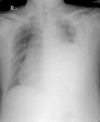Cardiac tamponade secondary to haemopericardium in a patient on warfarin
- PMID: 17711963
- PMCID: PMC2464639
- DOI: 10.1136/emj.2007.049643
Cardiac tamponade secondary to haemopericardium in a patient on warfarin
Abstract
Acute cardiac tamponade requires urgent diagnosis and treatment. We report a case involving a 70-year-old man who was receiving warfarin treatment for 12 years following mitral valve replacement. The international normalised ratio (INR) was checked and echocardiography performed regularly in the clinic. The last INR was 2.1, checked 2 weeks before admission to the emergency department. The last echocardiography performed 3 months previously revealed no pericardial effusion. The patient suffered from progressive dyspnoea and orthopnoea for several days. Cardiac tamponade was diagnosed, and the INR at that time was 7.52. Urgent pericardiocentesis and pericardiotomy were undertaken and 1300 ml of pericardial blood was drained. Following surgery the patient's recovery was uneventful. An intravenous vitamin K injection and fresh frozen plasma transfusion were administered to reverse the patient's over-anticoagulated state. The final pathology revealed chronic inflammation and there was no malignancy, and no bacteria or mycobacterium were seen. Emergency physicians should remember that over-anticoagulation with warfarin may contribute to certain complications, including haemopericardium, and that strict control of target INR should be the goal for patients who require continuous warfarin treatment.
Conflict of interest statement
Conflict of interest: None.
References
Publication types
MeSH terms
Substances
LinkOut - more resources
Full Text Sources
Medical

